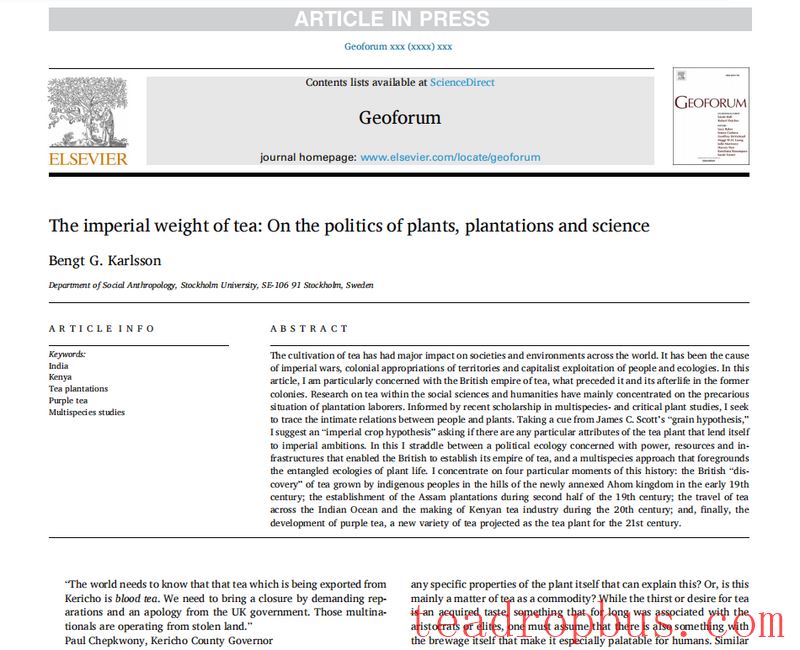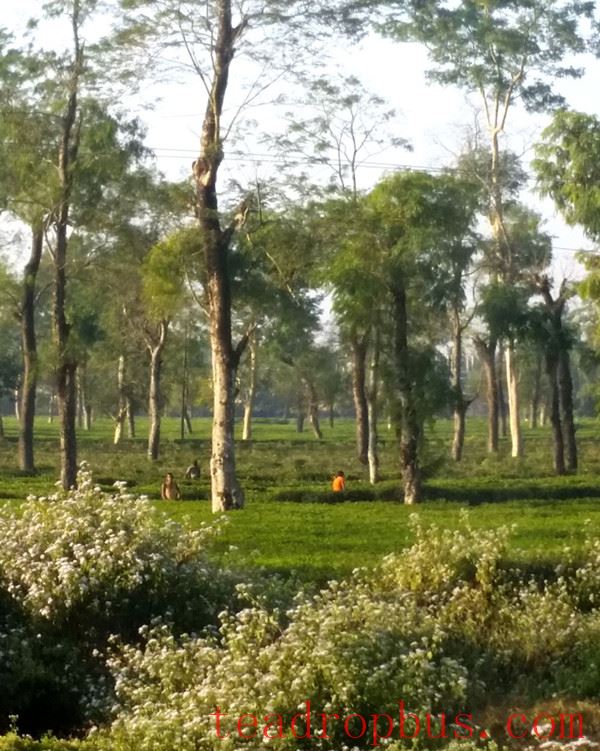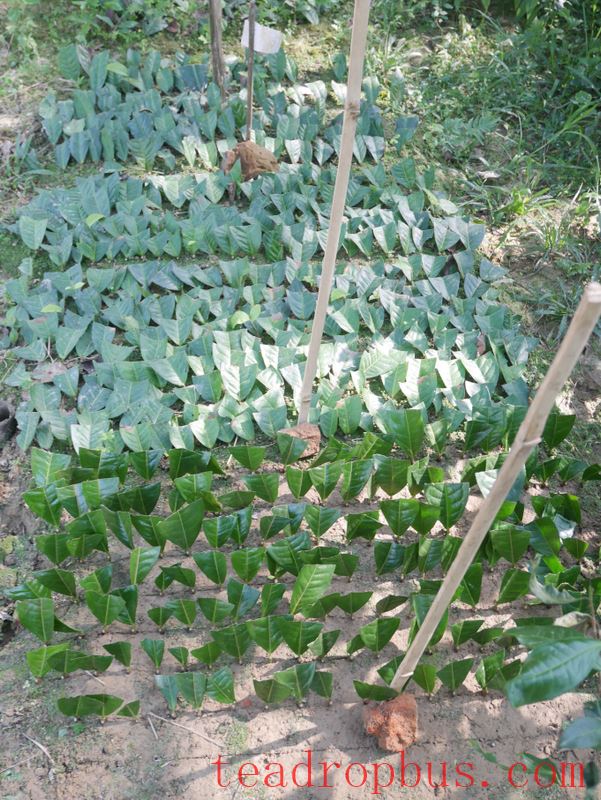Introduction: For three centuries, Tea has been entangled with power, stirring up storms in imperial wars, colonial expansion, scientific exploration, national independence movements, and global trade. Before the 19th century, China held an absolute monopoly on tea, but why did the British Empire, located far away on the British Isles, eventually become the tea empire? How did this mild temperate shrub transform into a sword of Damocles in the struggle for power and influence, and how did it usher in a new era in world history? This article shares insights from Bengt G. Karlsson, who, based on the “Imperial Crop Hypothesis,” traces key moments in tea's history to unravel the mysteries of its past.
Please refer to:
Bengt G. Karlsson. (2025). The imperial weight of tea: On the politics of plants, plantations, and science. Geoforum, in press.
The author uses historical research methods to focus on four critical historical stages of tea cultivation: 1) The discovery and annexation by the British in the early 19th century of tea cultivated by indigenous people in the mountains of the Assam Kingdom; 2) The establishment of Assam plantations in the second half of the 19th century; 3) The development of Chinese Tea through the Indian Ocean and the growth of the Kenyan tea industry in the 20th century; 4) The development of purple tea, the rising star of the 21st century tea tree. Through historical narratives and ethnographic interludes, the author outlines the evolution of tea varieties and cultivation forms and explores the symbiotic relationship between humans and tea trees. The author attempts to transcend the triple identity of tea as a “plant-crop-commodity” and proposes the Imperial Crop Hypothesis to explain what constitutes the “imperial character” of tea.
01 Why Tea? – The Proposal of the Imperial Crop Hypothesis
The imperial ambitions were infused into the waters of the temperate zones of the earth. Why did the empires choose tea as the rudder to control their colonies? By closely examining the tea plant and understanding the intimate relationship between tea and humans at specific historical junctures, the author argues that the reason lies in the intrinsic characteristics of tea.
The taste and addictive nature of tea made it highly favored by the aristocracy and elites, leading the British nobility and elites to launch a “land enclosure movement” for tea, further expanding their colonial territories. The suitability of tea for centralized production led to the proliferation of plantations in the colonies, which disrupted the traditional cultivation structures of Assam and attempted to establish a tea Eden. The perishability of tea required that harvested leaves be delivered to factories within hours, prompting merchants to scramble for territory, carrying the “concrete and steel” of processing plants. Assam thus became a “program” for tea, where everything was for tea, belonged to tea, and revolved around tea. The author believes that it was precisely due to the taste, addictiveness, suitability for centralized production, and perishability of tea that it became the “gentle blade” of the British Empire, turning Assam into a Stockholm syndrome captive of tea.
02 Exploitation and Rebirth – The Weight of Imperial Crops on Humans
The author outlines the impact of tea as a royal commodity on colonies and laborers in human history through historical narratives of the tea industry in Assam and Kenya and the recounting of the Blood Tea incident.
【Tea History in Assam】
In Assam, the history of tea cultivation is a condensed version of regional modern history. Following the failure of the massive migration of Chinese laborers and the establishment of new military garrisons, the city-states of Assam became even more sparsely populated, with locals choosing to flee the ill-fated plantation lands, leading to a labor shortage that put a halt to the expansion of plantations. However, the ruling British Empire clearly did not want to abandon this fertile land. Through strict economic support policies, they transformed it into a plantation economy catering to the world market. Massive infrastructure projects, deforestation to make way for plantations, and the mingling of different ethnicities reshaped Assam. The British transformed it into a plantation economy catering to the world market, resulting in changes to the local population structure, racial composition, infrastructure development, and a surge in foreign trade.

Figure: Assam tea plantation, photo by Juno
【Blood Tea in Kenya】
In Kenya, tea grew on soil stained with blood. Merchants vied for this new land suitable for tea cultivation, turning Kenya into a powder keg, with the probability of events spiraling out of control and political risks skyrocketing, accompanied by land disputes and racial issues. The Guardian reported on the tragic fate of the Gypsy Githi and Talai communities, whose homes were forcibly requisitioned for tea plantations, forcing them to relocate to “drought-stricken and disease-prone ‘native reserves.'” Those who were displaced or lost loved ones (over 100,000) are still seeking justice at the United Nations Human Rights Council in Geneva, hoping for compensation and apologies from the British government. However, so far, multinational companies operating the tea estates and the British government have not made any clear statements. This Blood Tea incident shone a harsh spotlight on the tea estates, exposing the exploitation of labor under capitalism to the world.

Figure: Musical “Alexander Hamilton,” excerpt from the Boston Tea Party
【Purple Tea in Kenya】
The Assam tea in Kenya is nurturing the rebirth of this soil. The author tracks the journey of the Assam tea factory across the Indian Ocean, shifting the focus to contemporary Kenya – the stronghold of smallholder tea agriculture. Smallholder tea agriculture in Kenya has challenged the traditional perception that tea is reserved for white settlers, diversifying production, opening rural areas to tourists, establishing factories, and building brands in pursuit of carving out their own niche in the global tea trade. In their eyes, decolonized purple tea is the path to success, and they hope to expand the purple tea business to create a renowned “African brand.” Although they are like a small boat adrift in the economic tide, these tenacious cultivators continue to strive to break and establish new patterns.

Figure: Clonal propagation of Toklai tea, photo by the author
03 Assimilation and Crisis – The Weight of Vegetation in Plantation Cultivation
· Plantations – The Black Utopia of Tea ·
Plantations represent a fragile form of vegetation growth. In plantations, all of the energy of tea plants is directed towards producing new leaves, forcing them into an unhealthy growth pattern. The cost of increased productivity is that the vegetation becomes extremely vulnerable to diseases and pests. To meet production demands, clonal propagation through asexual reproduction gained popularity in the tea industry, becoming the standard procedure worldwide using green cuttings. However, the introduction of high-yielding, genetically identical clonal teas into production reduces the resilience of plantations. Plantations and asexual propagation lead to reduced genetic diversity, making the tea industry more susceptible to diseases, pests, and climate change.
· Crisis · Relief · Obstruction ·
Scientists have realized that the production of clonal teas in plantations may ultimately lead to the extinction of the tea species. They have redirected their research towards enhancing the resilience of the species, hoping to find native Assam tea plants and optimize germplasm resources to help the tea plants survive this crisis. However, on the other side, Kenyan smallholders are obsessed with the introduction of purple tea clones, not only expanding into fields previously used for rice and food crops but also encroaching on pastures and forests, leading to further loss of biodiversity and depletion of ordinary villagers' resource bases. Kenya's biosafety is facing an unimaginable disaster, yet smallholder tea farmers are sacrificing